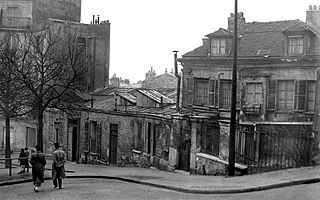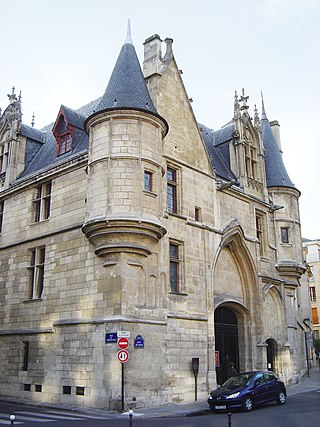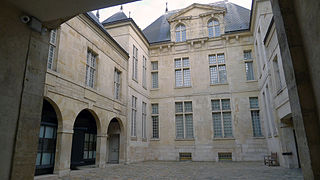
Montmartre is a large hill in Paris's northern 18th arrondissement. It is 130 m (430 ft) high and gives its name to the surrounding district, part of the Right Bank. Montmartre is primarily known for its artistic history, for the white-domed Basilica of the Sacré-Cœur on its summit, and as a nightclub district.
Montparnasse is an area in the south of Paris, France, on the left bank of the river Seine, centred at the crossroads of the Boulevard du Montparnasse and the Rue de Rennes, between the Rue de Rennes and boulevard Raspail. It is split between the 6th, 14th, and 15th arrondissements of the city. Montparnasse has been part of Paris since 1669.

Lapin Agile is a famous Montmartre cabaret, at 22 Rue des Saules, 18th arrondissement of Paris, France.

The Place du Tertre is a square in the 18th arrondissement of Paris, France. Only a few streets away from the Basilica of the Sacré Cœur and the Lapin Agile cabaret, it is near the summit of the city's elevated Montmartre quarter.

The Bateau-Lavoir is the nickname of a building in the Montmartre district of the 18th arrondissement of Paris that is famous in art history as the residence and meeting place for a group of outstanding early 20th-century artists such as Pablo Picasso, men of letters, theatre people, and art dealers. It is located at No. 13 Rue Ravignan at Place Emile Goudeau, just below the Place du Tertre.

The 18th arrondissement of Paris is one of the 20 arrondissements, or administrative districts, of the capital city of France. In spoken French, this arrondissement is referred to as dix-huitième.

The Marais is a historic district in Paris, France. It spreads across parts of the 3rd and 4th arrondissements on the Rive Droite, or Right Bank, of the Seine. Having once been an aristocratic district, it is home to many buildings of historic and architectural importance. It lost its status as a fashionable district in the late 18th century, with only minor nobles calling the area home. After the French Revolution, the district fell into disrepair and was abandoned by nobility. After a long period of decay, the district has undergone transformation in recent years and is now once again amongst the more fashionable areas of Paris, known for its art galleries, upscale restaurants and museums.

The arrondissement of Valence is an arrondissement of France in the Drôme department in the Auvergne-Rhône-Alpes region. It has 101 communes. Its population is 298,095 (2021), and its area is 1,516.3 km2 (585.4 sq mi).

The Montmartre Funicular is an inclined transport system serving the Montmartre neighbourhood of Paris, France, in the 18th arrondissement. Operated by the RATP, the Paris transport authority, the system opened in 1900; it was entirely rebuilt in 1935 and again in 1991.

Saint-Lazare Prison was a prison in the 10th arrondissement of Paris, France. It existed from 1793 until 1935 and was housed in a former motherhouse of the Vincentians.
The Musée d'Art Juif was a private museum of Jewish art located at 42, rue des Saules, in the 18th arrondissement of Paris, France. The nearest Paris Métro station is Lamarck – Caulaincourt on Line 12.

The Musée Cognacq-Jay is a museum located in the Hôtel Donon in the 3rd arrondissement of Paris.

The Musée de Montmartre is located in Montmartre, at 8-14 rue Cortot in the 18th (XVIII) arrondissement of Paris, France. It was founded in 1960 and was classified as a Musée de France in 2003. The buildings were formerly the home of several famous artists, including Pierre-Auguste Renoir and Suzanne Valadon.
This article presents the main landmarks in the city of Paris within administrative limits, divided by its 20 arrondissements. Landmarks located in the suburbs of Paris, outside of its administrative limits, while within the metropolitan area are not included in this article.

The quartier des Grandes-Carrières district is the 69th administrative district of Paris located in the west of the 18th arrondissement.

The Place Dalida is a square in Montmartre, in the 18th arrondissement of Paris, named after the Italian-French singer Dalida. Many fans and tourists visit the place to pay tribute to the artist.

The Cité internationale des arts is an artist-in-residence building complex which accommodates artists of all specialities and nationalities in Paris. It comprises two sites, one located in the Marais and the other in Montmartre. Approximately 1200 artists, choreographers, musicians, writers and designers from around the world live and work in the Cité internationale des arts every year. Residencies are generally a year long.

The Square Louise-Michel is a square on Montmartre in the 18th arrondissement of Paris, France. It is located in the Quartier des Grandes-Carrières. It is one of the largest green spaces in North Paris and is located next to the Sacré-Cœur. In 2021, it was reported to be the most visited free place in Paris following the 2019 Notre-Dame fire. The park features a carousel.















